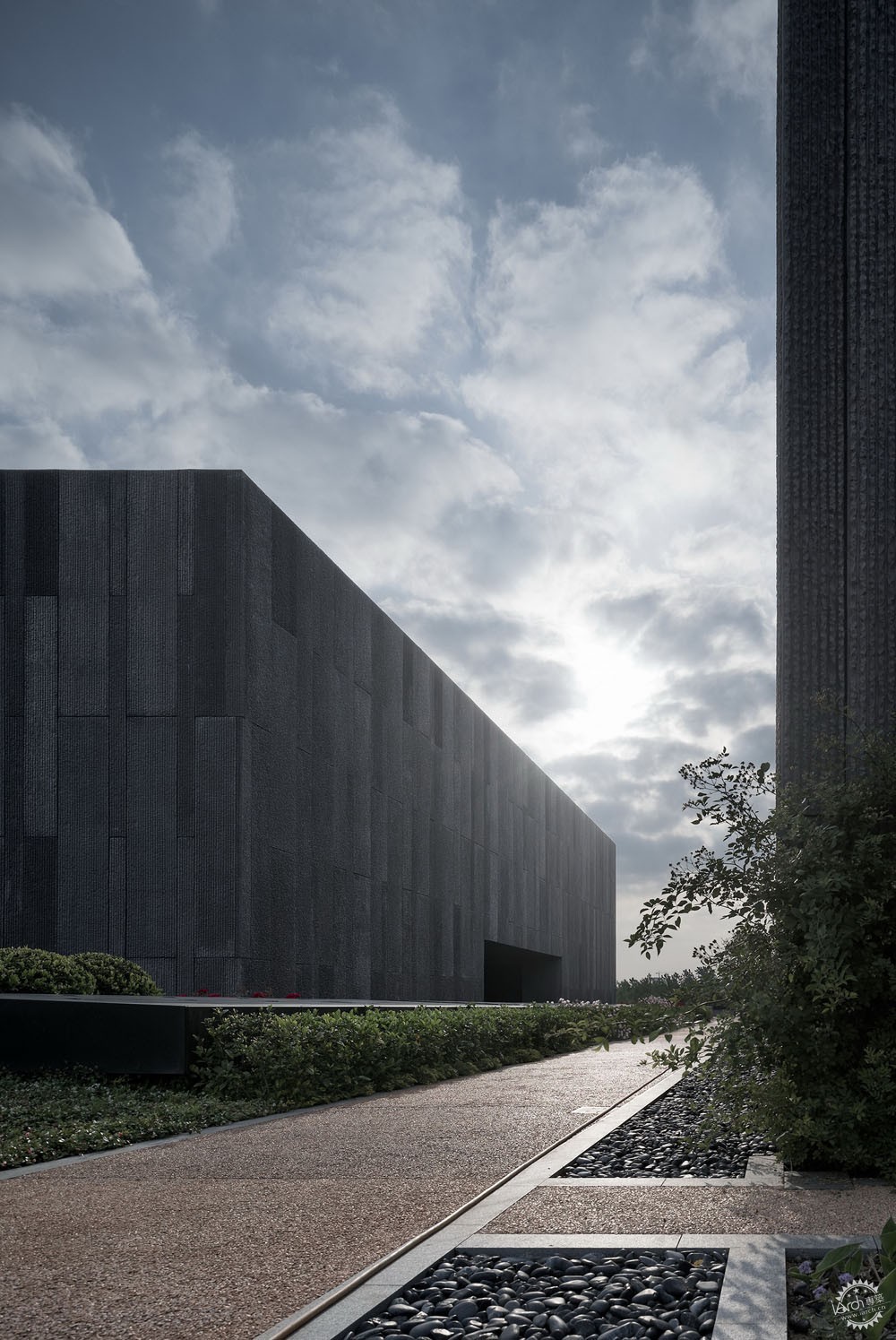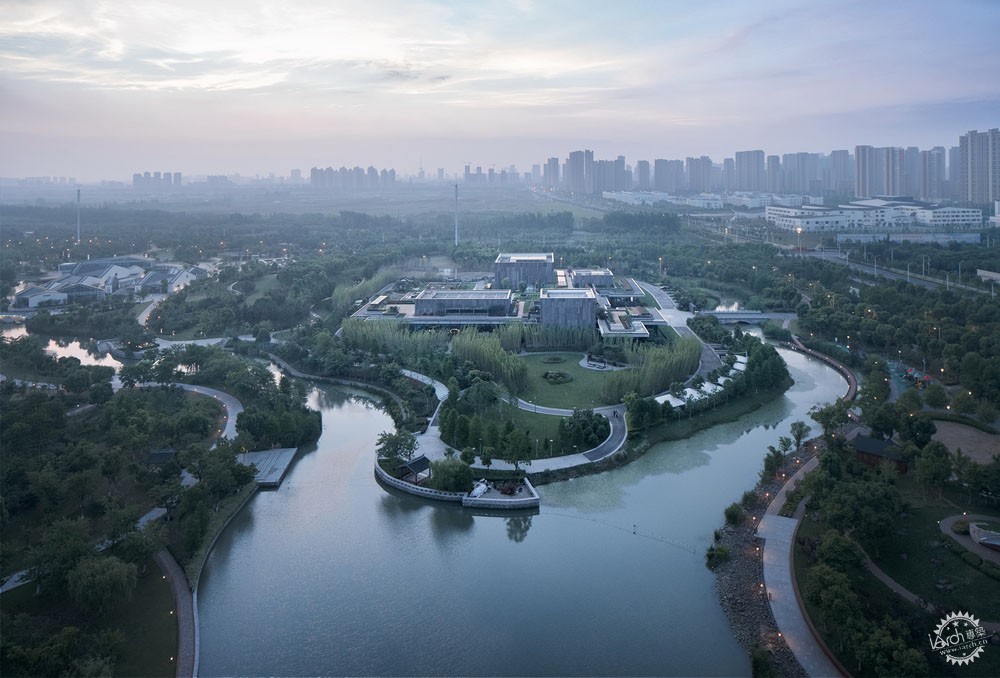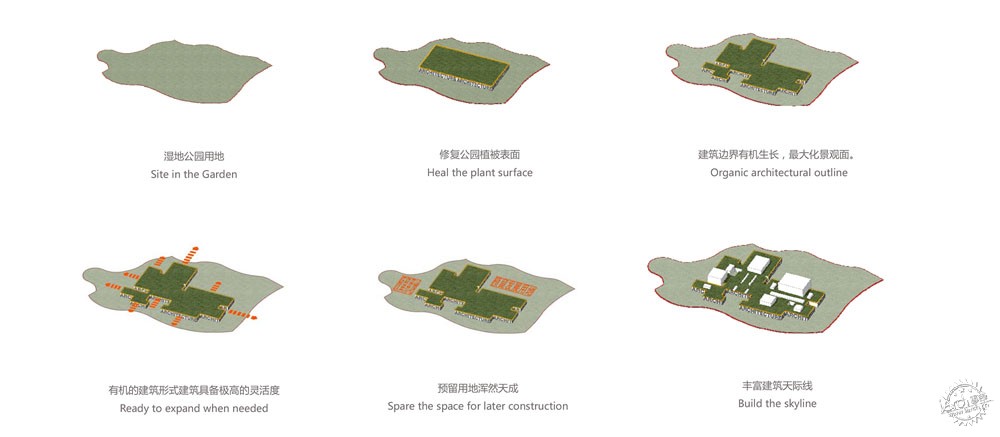
西南方向鸟瞰/Birdview from Southeast
唐仲英基金会中国中心
Cyrus Tang Foundation Center
唐仲英基金会中国中心作为唐仲英基金会在中国大陆的总部,是一座功能复杂的综合体。整个建筑需满足基金会日常的办公;用来存放基金会各种礼物的陈列馆;同时承担不定期来自全国各个成员高校团队的交流活动(展览、会议、培训等等)要求。
As the headquarters of Cyrus Tang Foundation (CTF) in mainland China, the project is a complex which integrates multiple functional spaces, including the foundation's offices, a museum for displaying various gifts that the foundation has received, and spaces for holding exchange activities with its college members, including exhibitions, conferences, and training, etc.

场地概览/Siteview
项目坐落于吴江松陵生态公园内的中心区块,地理位置优越,环境优美。整个设计以融合周边环境为出发点,并传承基金会 “服务社会,奉献爱心,推已及人,薪火相传” 的宗旨,可以提炼为消隐的和绿色的建筑。
Situated at the central area of East Tai Lake Ecological Park in Wujiang District, Suzhou, China, it enjoys favorable site conditions and beautiful landscape. The design focuses on the integration with the surrounding environment, inherits CTF's mission of serving disadvantaged communities with love and passing on the spirit of giving, and produces a "dissolved" and green building.
消隐的建筑
"Dissolved" Architecture

西南方向鸟瞰/Birdview from Southwest

主入口/MainEntrance
有机的平面
随着基金会的不断发展壮大,所需功能空间也会不断增加,设计充分考虑以后预留发展的空间需求,在不规则的用地范围内采用了有机的平面形式,建筑轮廓能够任意灵活的伸缩和调整。未来发展建筑可以从现有的布局自然的“延伸”出去而不破坏整体感。另一方面,曲折的外部轮廓可以破除建筑冗长单调的界面,这种穿插渗透式的布局策略也能将景观和建筑相互渗透,确保对环境景观造成最小程度的破坏。
Organic Layout
With the continuous development and growth of the foundation, its demands for functional spaces will continue to increase. The design fully considers the necessity of leaving space for future development and therefore applies an organic layout on the irregular site, to allow flexible expansion and adjustment of the building's outline. Future extensions can be constructed naturally alongside the existing layout, without destroying the overall unification and harmony. Additionally, the curvilinear contours break through the building’s monotonous interfaces, and the layout strategy of interpenetration enables the architecture to coexist with the natural landscape in the most environmentally friendly manner.

黎明鸟瞰/Birdview at dawn

屋顶花园/Roofgarden3
消隐的体量
建筑主要功能集中一层布置(层高7.0m),最大化减少对公园的压迫感。同时,一层屋顶花园又是被抬高的公园“植被”,既修复了生态公园的绿化界面。又是视野极佳的“观景台”,提供了优美的活动场地。局部凸出的建筑体量(陈列馆、展示厅、多功能厅等)退在屋顶花园后,犹如几个“雕塑”,强调建筑的“分量”感,也增加了整个建筑的空间层次。
"Dissolved" Volumes
Main functions are designed on 1F (storey height: 7.0 meters) in order to minimize the architecture’s intrusion to the park where it is located. Meanwhile, the rooftop garden functions as elevated vegetation, which not only increases the park's green area, but also provides a beautiful open viewing platform and activity venue for visitors. The protruding building volumes (museum, exhibition area, and multi-function hall, etc.) hide behind the rooftop garden, like a few sculptures, highlighting the “solidness” of the architecture while also strengthening the hierarchy of spaces.

从南侧看建筑/View from south

从西侧看建筑/View from west
消隐的立面
一层主要立以玻璃幕墙为主,不同明度绿色玻璃又韵律的组合,再加上幕墙立梃犹如“竹林”意向的衬托。整个立面作为维护结构被虚化。几个凸出体量的立面肌理也延续“竹子”的竖向分割,浑然一体。纯粹和完整的立面也是各建筑设备精心布局的结果:各设备管井和出口都统一整合在屋顶设计。
"Dissolved" Facades
1F is mainly enclosed by glazed curtain walls. Featuring a rhythmic arrangement of green glass with different transparency, its erected facade echoes the nearby bamboo and dissolves into the surroundings. Besides, facades of the protruding volumes also present bamboo-like vertical patterns, which blend together as an integrated whole. Those refined facades partly result from the elaborate arrangement of the building's equipment: all the tube wells and outlets are all integrated orderly in the roof design.
绿色的建筑
Green Building

屋顶花园鸟瞰/Birdview of roofgarden

室内/Interior
高效的布局
考虑到整个建筑使用的特殊性——除办公区域常年使用外,多功能会议区和展示区基本都是瞬时性使用,基金会中国中心采用集中式的布局,办公区、展示区、多功能会议区以及陈列馆集中于一个建筑综合体内,各功能分区既可以独立使用又能形成一个有效的整体运营。当独立使用时,在场地四周都分别设置了各区域的独立出入口。依据场地的空间特质,办公区和陈列馆布置在靠近场地的西侧和西南侧。保证了整个场地西侧安静的空间氛围,多功能会议区布置在场地的北侧,方便和北侧的室外活动场地相联系。展示区布置在东侧,靠近次入口。几大功能区块通过核心的过渡空间——中央大厅贯穿起来,既保证了相互之间的距离又能联系成一个整体。
Efficient Layout
Since only the office area is used perennially while the exhibition area and the multi-function conference hall are utilized occasionally, the design employs a centralized layout, where the office area, exhibition area, multi-function hall and museum are incorporated in one complex. Each functional space can be utilized independently, and at the same time enables efficient integrated operation with others. When utilized independently, each area is set up with its own entrance and exit. Based on site conditions, the office area and the museum are respectively located on the west and the southwest side, resulting in a tranquil ambience on the west part of the site. To connect with the northern outdoor activity venue, the multi-function conference hall is arranged on the north of the site. And the exhibition area is on the east side, next to the secondary entrance. All of those functional spaces are joined by the central hall, which ensures the proper distance among each section as well as the unity of the building.

屋顶花园/RoofGarden

屋顶花园/Roofgarden2

屋顶花园及庭院/Roofgarden and Court
绿色的技术
本项目通过节地、节能、节水、节材等各种生态技术的运用,在2014年获得了国家“二星级绿色建筑设计标识”证书。在最初的方案设计阶段中就借助模拟软件对建筑形体的自然通风和采光进行优化分析。 使用国内现有成熟的绿色建筑技术如地源热泵、太阳能光伏一体化、导光照明技术、屋顶绿化、建筑自动遮阳、绿色照明、智能化运营管理等。另一方面,建筑不仅能够高效和节能的运作,同时也吸收了各成员高校可提供的高新技术资源,是一个绿色建筑技术展示的模范平台。
Green Technologies
This project won the Chinese Certificate of Green Building Design Label (Two Star) in 2014, for its application of many fully developed green technologies in China, such as geothermal heat pumps, building-integrated photovoltaics, tubular daylight devices, green roof, automated shading system, green lighting and intelligence operation management that saves land, energy, water and building materials. During the initial design process, simulation software was used for the optimized analysis of the building’s natural ventilation and lighting. On the other hand, this is not only an efficient and eco-friendly architecture, but also an exemplary platform for display and exchanges of green technologies, which gathers high-tech resources that universities have brought in.

从西侧鸟瞰/Birdview from west

玻璃幕墙细节/Curtainwall details
唐仲英基金会中国中心是一个各专业统一整合,高效协作的成果。绿色设计、功能优化以及与场地相呼应始终贯穿于整个设计过程中,最终呈现出一个同周边自然环境相融合,和谐共生的建筑。
The architecture is the outcome of effective multi-disciplinary integration and collaboration. Green designs, functional optimization and fusion with the site were fully considered throughout the design process, thereby an architecture that blends and coexists with the ambient natural environment was created.

从东南侧看建筑/view from Southeast

材料对比/MaterialContrast

立面细节/FacadeDetails

立面细节/FacadeDetails

庭院/Courtyard

区位图/SiteLocation

草图/Sketch

建筑形态生成分析图/Mass generation

一层平面/Firstfloor Plan

二层平面/Secondfloor Plan

立面图/elevation
项目位置:江苏省苏州市吴江区东太湖生态园内
建筑面积:15000平方米
主要材料:SRC 玻璃纤维水泥板——上海盈创、 屋面绿化、玻璃幕墙
设计师:董丹申、杨易栋、滕美芳、林再国
设计及工程总体控制:浙江大学建筑设计研究院有限公司(http://www.zuadr.com/)
室内设计: 伍兹贝格、杭州典尚设计
景观设计: 中国美术学院风景建筑设计研究院郑捷所
结构工程师:张明山、徐成、李本悦
设备工程师:李浩军、龚增荣、董绍兵、黄正杰、刘海峰
摄影师: 赵强
Location: East Tai Lake Ecological Park, Wujiang District, Suzhou, China
Area: 15,000 ㎡
Main materials: SRC, roofing plant, glass curtain wall
Architects: Dong Danshen, Yang Yidong, Teng Meifang, Lin Zaiguo
Architectural design firm: The Architectural Design and Research Institute of Zhejiang University Co., Ltd. (UAD)
Architectural design firm website: http://www.zuadr.com/
Interior design: Woods Bagot, Hangzhou Dianshang Building Decoration Design
Landscape design: The Design Institute of Landscape & Architecture China Academy of Art (Zheng Jie Studio)
Structural engineers: Zhang Mingshan, Xu Chen, Li Benyue
MEP engineers: Li Haojun, Gong Zengrong, Dong Shaobing, Huang Zhengjie, Liu Haifeng,
Photographer: Zhao Qiang
来源:本文由浙江大学建筑设计研究院有限公司提供稿件,所有著作权归属浙江大学建筑设计研究院有限公司所有。
|
|
